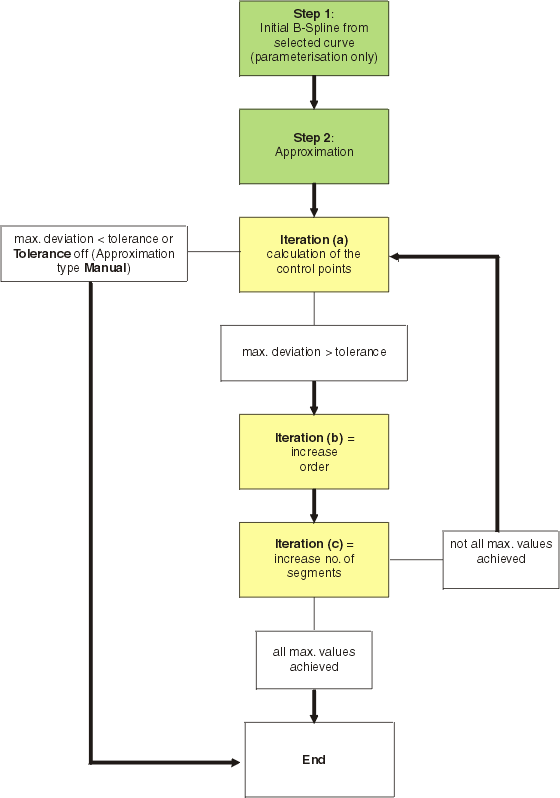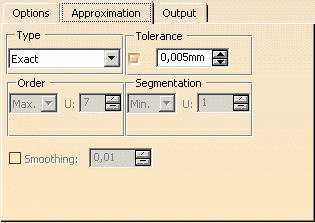The approximation is computed in two steps:
- Creation of an initial B-Spline
With the first step, for each selected curve is created an initial B-Spline, defining the parameterization and the number of control points, but not their values. The B-Spline results from the B-Spline of the curve to be approximated as well as from the minimum and maximum values of the order and the number of segments specified by the user:
Order and number of segments of the B-Spline are taken from the curve to be approximated, if they are within the specified minimum and maximum ranges. Otherwise, they are increased or reduced to the corresponding minimum or maximum value.

Note: If in the selected geometry G2 discontinuities are found, they are transferred as sharp bends to the initial B-Spline. In this case, the initial B-Spline may contain more segments than the maximum value specified for the Segmentation. - Iterations
After the creation of the initial B-Spline, the actual approximation is computed in the second step. This is realized by a three-step iteration:
- Iteration (a)
In the first iteration, the (optimal) values of the control points of the B-Spline are computed using a Newton method. The control points allow the computation of the maximum deviation between the computed approximation curve and the original curve. If this value is smaller than the tolerance value specified by the user, the iteration is terminated successfully.
- Iteration (b) + (c)
If the computed deviation is larger than the tolerance specified, the B-Spline will be modified by increasing order and number of segments, and the iteration (a) is restarted.
Independent from the approximation type set, first the order and then the number of segments is increased. This way, the number of segments of the created curves can be minimized.
- Iteration (a)
Structure view of the approximation


- Type: In this popup menu, you can select the approximation type:
- Exact: The options Order and Segmentation are inactive, as these parameters cannot arbitrarily be specified. For the maximum order, the value is internally set to 7, the maximum number of segments is unlimited.
- Order: With this option the Order can be specified. The number of segments from the
previous calculation is displayed and can be reduced by increasing the order. The number of segments created is displayed
within the frame Output Result.
This option should be used as a a post-processing operation to improve the previous result. - Segmentation: With this option the Segmentation can be specified. The order from
the previous calculation is displayed. The system tries to meet the given Tolerance by introducing segments with the order
used for the pre-processing.
his option should be used as a a post-processing operation to improve the previous result. - Manual: All parameters can be arbitrarily specified. A deviation from the tolerance specified is possible
- Before using the options Order and Segmentation it is recommended to use the automatic option Exact before as a kind of pre-processing.
- If the approximation type Exact is activated after Manual, the settings of the options Order and Segmentation are set to the values internally specified for these approximation types. After returning to the approximation type Manual its values are not restored.
- Tolerance: The tolerance value defines the accuracy in which the output geometry should created.
- Order:
- Min.: The order of the selected geometry being below this value is increased until it reaches this value. For the approximation the order can be increased until 7 at maximum.
- Max.: The order of the selected geometry being above this value is reduced until it reaches this value. For the approximation the order cannot exceed this value.
- Fix: Increase and/or decrease the order of all selected elements until it meets exactly the order specified here. For the approximation, the order cannot have another value than the specified one.
- Segmentation:
- Min.: Increase the number of segments of the selected geometry which is below this value until it reaches this value. For the approximation the number of segments can be arbitrarily increased.
- Max.: The number of segments of the selected geometry being above this value is reduced until it reaches this value. For the approximation the number of segments cannot exceed this value.
- Fix: Increase and/or decrease the segmentation of all selected elements until it meets exactly the segmentation
specified here. For the approximation, the number of segments cannot have another value than the specified one.

Note: If in the selected geometry G2 discontinuities are found, they are transferred as sharp bends. In this case, the result may contain more segments than the maximum value specified Segmentation: Max. or Fix.
- Smoothing: This option allows the desired compromise between an exact approximation and a very smooth curve.
By using this option the function tries to equally distribute the control points of the resulting geometry.